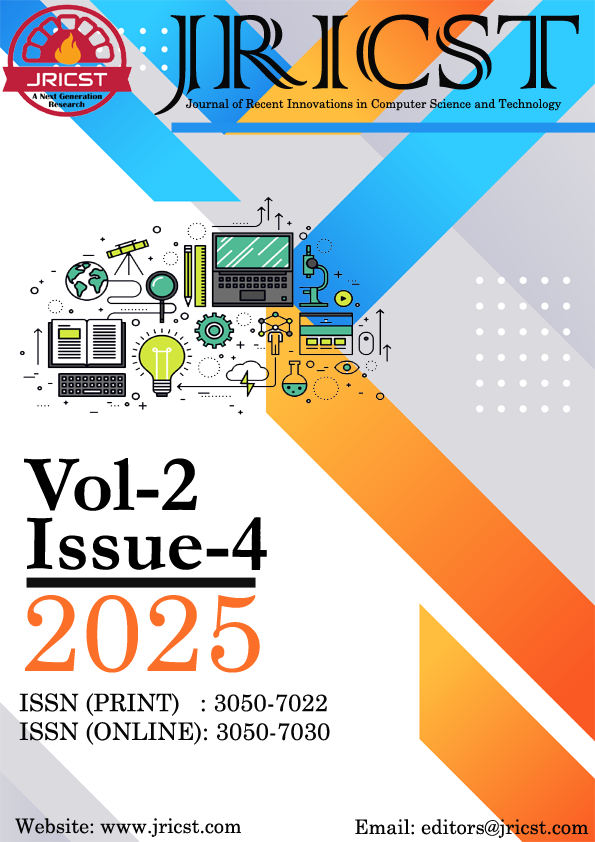AI-Driven Online Exam Proctoring: An Enhanced Machine Learning Approach
DOI:
https://doi.org/10.70454/JRICST.2025.20405Keywords:
Online Exam Proctoring, Artificial Intelligence (AI), Machine Learning (ML) , Convolutional Neural Network, Educational TechnologyAbstract
The proliferation of an online learning environment has opened up tremendous potential in the sphere of education, but has also posed significant problems to examination integrity. Conventional services of online proctoring, i.e., manual webcam supervision and lockdown browsers, failed to provide fairness since they were either inefficient or rather effortless to manipulate. This paper introduces an AI-based online exam proctoring (OEP) model that combines both visual and audio channels to identify cheating behavior, such as reading notes or using cell phones, muttering, or turning away the view on the examination. The research builds on a previously established framework that uses Support Vector Machines (SVMs), and tries different alternatives by using Random Forests (RF), Convolutional Neural Network (CNN), and Long Short-Term Memory (LSTM) models. A comparative analysis shows that the baseline system displayed an average True Detection Rate (TDR) of 87% under 2% False Alarm Rate (FAR) whereas the enhanced model with CNN-based visual processing and LSTM educated speech detection produced an improved system performance to 94% TDR at the same FAR limitation. The results indicate the potential of advanced ML to circumvent the drawbacks of earlier solutions and point to a way forward that results in scalable, fair, and privacy-sensitive proctoring solutions.
Downloads
References
[1] H. Alvi, M. Khan, and S. Raza, “Temporal modeling of online behavior for proctoring using LSTMs,” Journal of Educational Technology, vol. 19, no. 3, pp. 44–58, 2022.
[2] T. Nguyen, H. Pham, and M. Tran, “Eye-tracking based online examination supervision,” Computers & Education, vol. 138, pp. 82–94, 2019.
[3] F. Rahim, S. Kumar, and R. Yadav, “Identity verification in online exams through facial biometrics,” International Journal of E-Learning Security, vol. 10, no. 2, pp. 55–67, 2020.
[4] A. Singh, P. Verma, and N. Gupta, “Ensemble learning for robust classification in noisy environments,” Pattern Recognition Letters, vol. 165, pp. 134–142, 2023.
[5] L. Zhang, Y. Chen, and H. Wang, “Deep learning approaches for real-time text detection in online examination systems,” IEEE Access, vol. 9, pp. 118733–118745, 2021.
[6] R. Sharma and P. Das, “Ethical implications of online proctoring: Balancing integrity and privacy,” Educational Review, vol. 73, no. 4, pp. 512–528, 2021.
[7] J. Lee, Y. Park, and S. Kim, “Multimodal fusion strategies in AI proctoring,” Applied Artificial Intelligence, vol. 36, no. 7, pp. 648–663, 2022.
[8] D. O’Connor and K. Murphy, “Academic integrity in the digital age,” Journal of Higher Education Policy and Management, vol. 40, no. 3, pp. 281–295, 2018.
[9] N. Patel and R. Joshi, “Lightweight CNNs for edge-based educational applications,” Journal of Machine Learning Applications, vol. 5, no. 2, pp. 67–81, 2024.
[10] Y. Chen and L. Xu, “Advances in multimodal cheating detection: A survey,” Artificial Intelligence Review, vol. 53, no. 5, pp. 3897–3925, 2020.
[11] S. Salunkhe, N. Shende, N. Shah, S. Ubale and S. Kamble, "Automated Online Exam Proctoring System Using Computer Vision Hybrid ML Classifier," 2025 International Conference on Emerging Trends in Industry 4.0 Technologies (ICETI4T), Navi Mumbai, India, 2025, pp. 1-4, doi: 10.1109/ICETI4T63625.2025.11132237.
[12] W. Y. Leong, "Enhancing Academic Integrity in E-Exams Through AI-Driven Proctoring Technologies," 2025 14th International Conference on Educational and Information Technology (ICEIT), Guangzhou, China, 2025, pp. 392-396, doi: 10.1109/ICEIT64364.2025.10975939.
[13] S. Srivastava, N. N. Kumar, K. M, C. G. Varshini, B. P. M and S. S. T, "A Review on AI - Powered Digital Identity Authentication for Remote Examination," 2025 6th International Conference on Mobile Computing and Sustainable Informatics (ICMCSI), Goathgaun, Nepal, 2025, pp. 1243-1247, doi: 10.1109/ICMCSI64620.2025.10883372.
Downloads
Published
Issue
Section
License
Copyright (c) 2025 hemendra sharma Shanker, Vinay Kumar Pant (Author)

This work is licensed under a Creative Commons Attribution 4.0 International License.
This is an Open Access article distributed under the term's of the Creative Common Attribution 4.0 International License permitting all use, distribution, and reproduction in any medium, provided the work is properly cited.






